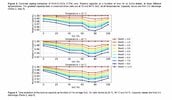I suppose, but even though I REALLY baby my battery, I don't even go that far. I just charge to 100% the night before using my normal start time. I suppose it does get done around 4 hours before departure, but I'm not so concerned about getting the timing right. It's not like I'm traveling very often.
Leaving it at 100% is not even near as bad as people think.
In many cases 100% is compareble with 80% and in some cases even better than 80%.
”Baby the battery” should be uding very low SOC. Charge late and never more than needed until next possible charging session. As 50% is the lowest setting this would be the best possible, except setting the charge to reach sufficiebt level when staring the drive, enabling for example the possibillity yo have the car sleeping at very low SOC and only let charge to the daily needed level like 20-30% or so.
This is the regular look of calendar aging research:
NCA is the thing to look after for LR/P in US.
And this is how it might look;
NCA, 2170:



